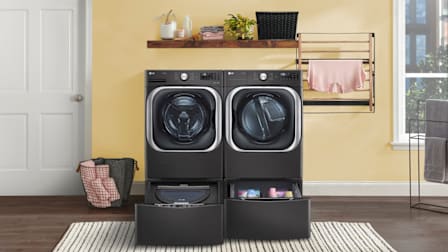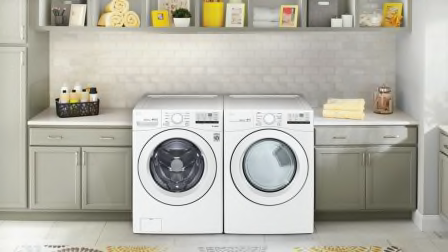Best and Worst High-Efficiency Top-Load Washers of 2025
These top-load washers are friendly to the ecosystem and your wallet—plus, they can save time and handle large loads
When you shop through retailer links on our site, we may earn affiliate commissions. 100% of the fees we collect are used to support our nonprofit mission. Learn more.
High-efficiency (HE) top-load washers are like the middle child of laundry appliances. They’re not as popular as top-load agitator washers and not as cool-looking as those sleek front-loaders. While HE top-loaders get little appreciation, the best ones have enough positives to warrant regular recommendations by Consumer Reports.
- HE Top-Load Washers: Best Worst
- How CR Tests Washing Machines
- How They Work Their Advantages Their Disadvantages
Best HE Top-Load Washers
The best HE top-load washers in our ratings all hail from LG, a brand that earns a top-notch reliability rating and above-average owner satisfaction rating in our member surveys. All four machines hit our washing and water-efficiency tests out of the park, and all four have earned CR’s Green Choice designation, meaning they are among the most eco-friendly models you can buy.
Worst HE Top-Load Washers
These three HE top-load washing machines didn’t perform well in their main job of washing out stains, and our testers also found that they used a lot of water in the process.
How CR Tests Washing Machines
To test how good a washing machine is at cleaning clothes, CR’s testers use fabric swatches stained with red wine, cocoa, carbon (which is similar to soot), and other hard-to-remove stains. They analyze each swatch with a spectrocolorimeter before and after washing. The lighter the stain after laundering, the higher the machine scores in washing performance.
We also evaluate how gentle a washer is on fabrics, and record the amount of water and energy each machine uses. We also record the energy needed to dry the laundry we just washed: Washers that extract more water shorten dryer time and score higher in our energy-efficiency tests. Water- and energy-efficiency scores are among the factors we use to determine the Green Choice designation for washers.
Our testers also measure how much vibration the washer transmits to a wood floor, and our panelists judge the washer’s noise levels during the fill, agitate/tumble, drain, and spin cycles.
In addition to the lab test results, we incorporate each washer brand’s reliability and owner satisfaction scores from CR’s member survey into the Overall Score for each washer.
How HE Top-Load Washers Work
HE top-load washers operate differently from front-loaders and top-load agitator models. They use an impeller (a low-profile disc with fins in the bottom of the drum) to clean clothes by rotating and rubbing fabrics against each other using minimal water (an average of 13 gallons per load).
That’s why some top-rated HEs achieve an eco-friendly Green Choice status, CR’s exclusive designation for washers that have less of an impact on the environment.
This compares with top-load agitator machines, which deep-fill the tub with 20 or more gallons of water and clean clothes using a twisting center spindle. Front-loaders gently spin the drum clockwise and counterclockwise to flip clothes in and out of even less water (about 10 gallons per load).
If clothes inside an HE top-loader get out of balance, the machine will attempt to rebalance the load by adding more water to improve circulation and even things out. If that doesn’t work, you’ll get an error message alerting you to manually rebalance the load.
“HEs use less water than top-load agitators but more than front-loaders,” says Rich Handel, CR’s laundry expert. “They are more gentle on your laundry than agitators but more aggressive than front-loaders. So sometimes they tangle the items up.”
Advantages of HE Top-Load Washers
HE top-loaders are a happy medium between top-load agitators and front-loaders, hitting the sweet spot in terms of price, size, and convenience. So if you’re looking to get an upper hand on inflation, a high-efficiency top-load washer could be a good choice for the following reasons:
They’re easy to load. Compared with cramped top-load agitator machines and front-loaders that require back-bending, these larger machines are easy to load from the top.
They’re reasonably priced. Most HE top-load washers cost $500 to $1,100, $200 to $300 less than typical front-loaders, and only about $100 more than typical top-load agitator washers.
They’re efficient in water usage. Thanks to faster-spinning drums, HE top-load machines offer better water efficiency and water extraction.
They’re faster than front-loaders. Their wash times fall in between that of top-load agitators and front-loaders, generally 60 to 80 minutes using the heavy-soil setting.
They can tackle large loads. Like front-loaders, most HE washers have no problem with big loads of beach towels and comforters, thanks to a high-capacity tub of up to 5.5 cubic feet. Just know that if you stuff it full, you may sacrifice a little on washing performance.
Disadvantages of HE Top-Load Washers
Our member surveys and tests have found that high-efficiency top-load machines may have problems with washing and inconsistent cleaning, and some have a tendency to twist items.
Your laundry may get tangled. According to our 2023 survey, CR members cited tangled or balled-up laundry as their biggest problem with high-efficiency washers, especially among four brands: GE, Kenmore, Maytag, and Whirlpool. This may be why most HE top-load washers receive middling ratings for owner satisfaction in our survey. Running an extra rinse cycle can remove residual detergent from twisted clothes. But you’ll save both money and water if you simply dial back on your detergent use a bit. “If you use the correct amount of detergent, an extra rinse may not be necessary,” Handel says. “If you are sensitive to detergent residue, it’s an extra precaution.”
Your clothes may not get thoroughly cleaned. Kenmore, Maytag, Samsung, and Whirlpool were called out on this problem. Based on our lab tests, HE washers appear less effective in cleaning clothes than front-loaders but more effective than top-load agitator machines.

































